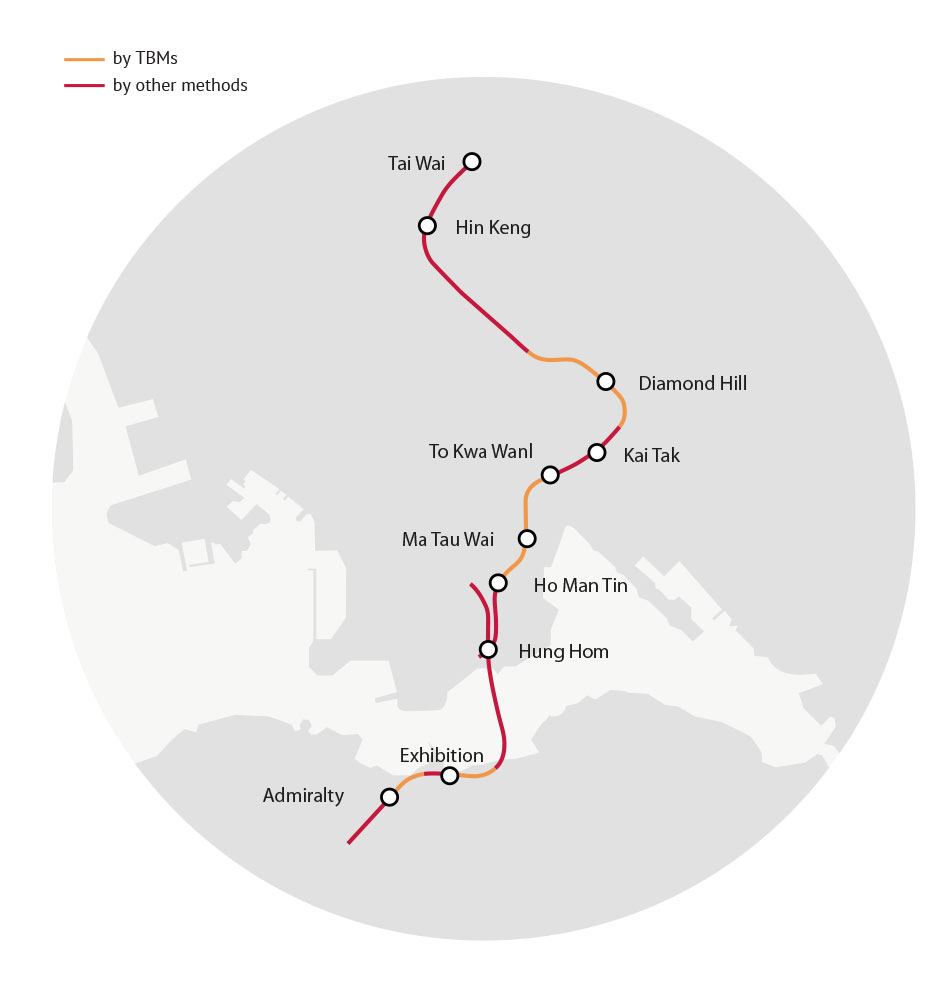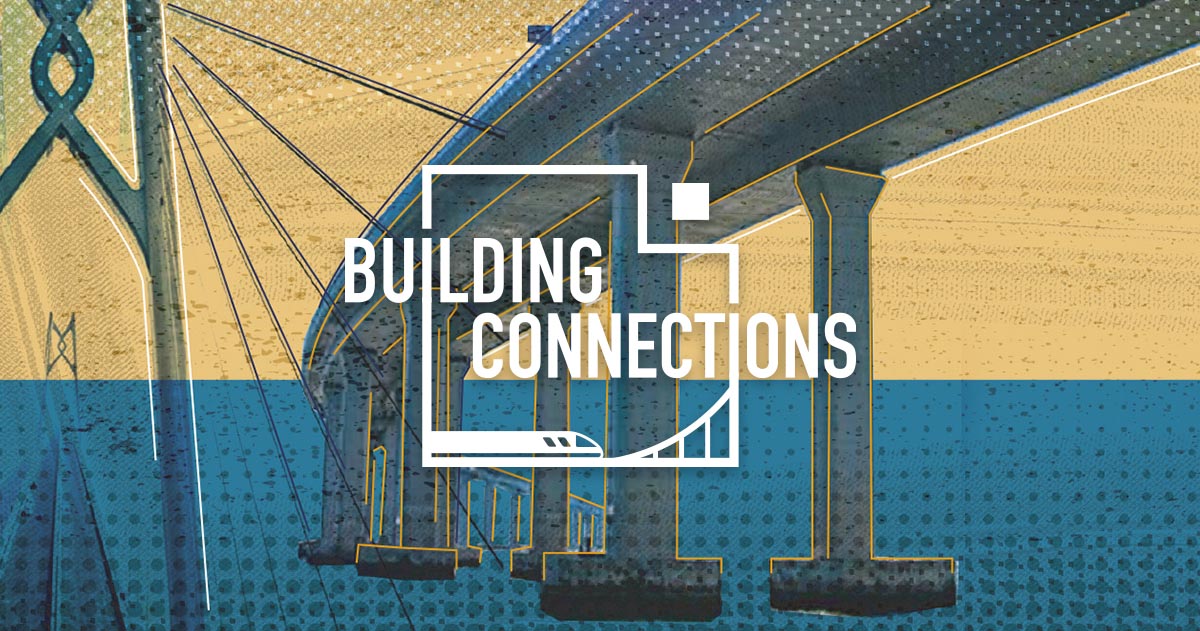Chapter 2
The journey: from innovative idea to high-tech reality
Discover how the new, super-fast rail link to the Mainland came into being, as we explore the rail link’s construction process.
It’s been almost two decades since the idea for an express railway system linking Hong Kong and China was first considered. A vast amount of planning and work has gone into this project, from feasibility and environmental studies to constructing 26km of underground tunnels, not to mention building the terminus in West Kowloon. Here is a look at the history of the high-speed rail, the challenges it faced, and an insight into how it all came together.
A timeline of events taking the high-speed rail from notion to new phenomenon
May, 2000Idea comes to light
The government first floats idea of a regional express line linking urban areas to the border with the Mainland. The ‘Regional Express’ first appeared in the Railway Development Strategy 2000 study prepared by the Transport and Housing Bureau, a report looking at solutions to linking the border with metropolitan Hong Kong
Oct, 2001Plans announced
The Chief Executive announces plans to build a high-speed rail link connecting Hong Kong with Shenzhen, also linking with an express rail line to Guangzhou
Jul, 2005Two possible routes
The Kowloon Canton Railway Corporation puts forward two possible routes. The first involves the new rail line sharing tracks with the Kowloon Southern Link (KSL, now under construction) and the West Rail line (WR). The second option involves building a new track dedicated solely to the new rail line
Jan, 2006An initial route decision
At the Executive Council meeting, the Chief Executive decides the new rail link will share tracks with the KSL and WR
Apr, 2007Rethinking the route
New stations on the China railway line, a need for wider express trains and tracks make the shared-track option increasingly complex. Plus the growing number of passengers between Hong Kong and China make it clear this path is no longer viable. The government decides to build a new, dedicated track instead
Oct, 2007An economic growth plan
The government announces plans for the Guangzhou-Shenzhen-Hong Kong Express Rail Link – one of 10 major infrastructure projects intended to boost economic growth
Apr, 2008Planning underway
The Hong Kong government asks MTR Corporation to carry out further planning and design work for the proposed high-speed rail link
The government says a task force has been set up to look at how to manage immigration and customs clearance at the West Kowloon terminus
Dec, 2009Applying for funding
The government submits a request for HK$66.9 billion in funding for the Hong Kong section of the cross-border rail project, to be completed in 2015
Jan, 2010Funding secured
The Legislative Council’s Finance Committee approves the funding application for the construction of the high-speed rail link. Construction of the high-speed rail begins at the end of the month. Discussions with conservationists and villagers continue
Apr, 2014Opening set for 2017
MTR Corporation extends the opening of the new high-speed rail link to 2017
Aug, 2014Costs rise
MTR Corporation reveals the new high-speed rail will cost HK$71.5 billion
Dec, 2014Immigration arrangements announced
The Transport and Housing Bureau reveals co-location arrangement that will allow mainland Chinese officers to enforce mainland immigration and laws at the West Kowloon terminus, in order to speed up the immigration process
Jun, 2015New opening date proposed
MTR Corp moves the rail link’s opening date to the third quarter of 2018
Nov, 2015Agreeing on cost
According to an agreement between MTR Corporation and the government, the government will bear and finance project costs up to HK$84.4 billion. MTR Corporation will finance any costs beyond this
Jun, 2017Finalising joint checkpoint arrangements
The Transport and Housing Department says negotiations with Beijing over joint checkpoint arrangements have reached the final stage
Jul, 2018Co-location bill passed
The Legislative Council passes the Guangzhou-Shenzhen-Hong Kong Express Rail Link (Co-location) Bill, designating an area within the West Kowloon terminus where passengers will clear Mainland immigration while still in Hong Kong
Aug, 2018Launch date confirmed
It is announced the rail line will debut on September 23, 2018
Sept, 2018The journey begins
The high-speed rail between Hong Kong and Shenzhen opens
Building the high-speed rail line
One of the most challenging aspects of the construction process is the fact that the 26-km route runs entirely in underground tunnels. To overcome these challenges, MTR Corporation used several different construction methods to build what is now Hong Kong’s longest railway tunnel system.
These consist of the cut-and-cover method, drill and blast method, and using tunnel boring machines (TBMs) to construct the main tunnels at Yau Tsim Mong, Sham Shui Po and Yuen Long.
Exploring construction methods
The nature of the ground determines which method is most effective. The cut-and-cover method is ideal when tunneling through soil, while the drill and blast method works well when tunneling through rock. Weighing roughly 1,000 tonnes, TBMs are effective on soil, rock, or a mixture of both.
In terms of cost, the tunnel boring machine method (TBM) is the most expensive because the equipment involved can be costly. The diameter of a TBM is at least 6m high, which is equivalent to two storeys tall, and it weighs about 1,000 tonnes.

How it was all done
The new rail link was a colossal construction achievement.
A total of six mixed-ground TBMs – featuring cutterheads – rotated and rolled over the ground at the surface, separating earth and rock into smaller segments. Large, pyramid-shaped equipment known as ‘hoppers’ received the excavated material, removing it from the site by discharging it onto a vast conveyer belt system that extended backwards through the central body of the tunnel-boring machine.
Around 20 people operated and monitored each TBM underground as it worked. On the surface, another 10 people provided tunneling logistics support.
Construction process
1. Excavate launching shaft and retrieval shaft.
2. Assemble the TBM at the launching shaft.
3. Cut and excavate the tunnel.
4. TBM arrives to be dismantled for transportation.
Tunnel sections constructed by TBMs
The nature of the ground determines which method is most effective. The cut-and-cover method is ideal when tunneling through soil, while the drill and blast method works well when tunneling through rock. TBMs are effective on soil, rock, or a mixture of both.
How did the weather affect the build process?
Severe weather phenomena, such as summer monsoons and tropical cyclones, were one of the greatest challenges during the construction process. In 2017 alone, monthly rainfall was more than 190mm for six months.


